-
Hi all,
Just joined. I've been lurking for a bit, since I recently picked up this guitar in question a couple months ago. Truthfully, I've kind of been all over the net, looking for info on this model, which is a bit scarce it seems. So here goes...might be long, sorry.
Here's the guitar in question;
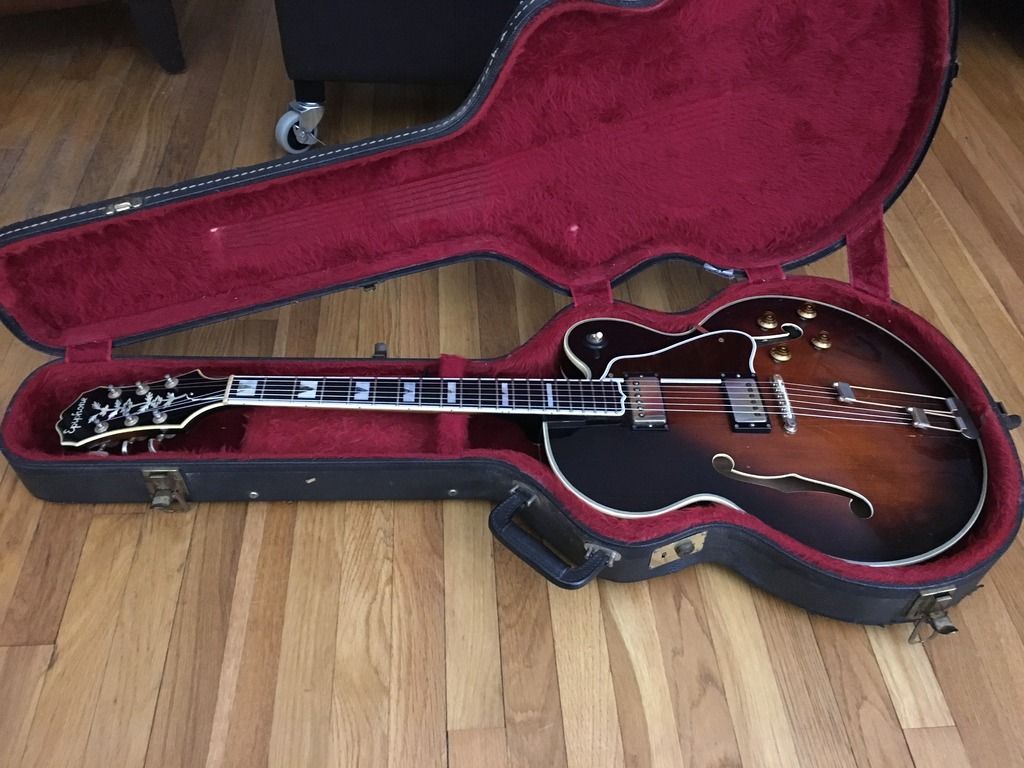
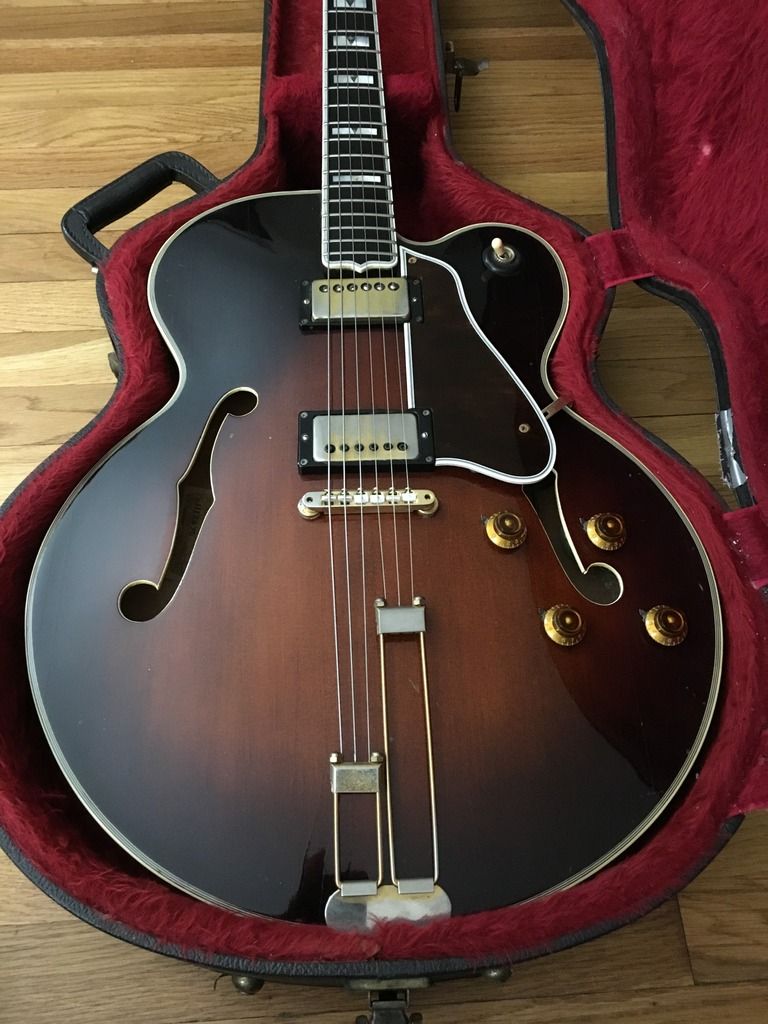
Those with familiarity with these (and perhaps good eyes) will note there's been a host of pieces changed out. Pickguard, bridge, knobs, pickups, etc...
The pickups in it now are a SD SH1b in the neck, and a Dimarzio of unknown model/vintage in the bridge. I've been playing it through a Vox VT40+, and while I like the SD, the Dimarzio just doesn't look or sound the part. So I've decided, whereas the guitar has already been so modified and will never be original, to modify it further, starting with a set of gold covered SD Seth Lovers.
I sent off and email to Gibson, inquiring about purchasing a tailpiece for a current production Epi Broadway. I got their reply and yes, you can actually order one through an authorized Gibson/Epiphone dealer. The SKU number is PTP-113 if you're so inclined. I figured once the new pickups go in, they'll make the original 36 year old, faded out Frequensator look, well..meh. The nice thing about this part over the generics available is it's actually stamped FREQUENSATOR Pat Pend.
Which brings me to this...
What I'm wondering about is the harness in these. Mine still has the original intact, and everything functions correctly. The pots have this weird shielding cover over them which makes them hard to ID. My inspection mirror is a bit too big to get in through the F hole to get a clean look at things.
What pots and caps did they use? I'm not sure if the pots are 250 or 500K. Has anyone here rewired one of these completely? Whoever replaced the pickups back when simply cut the leads off the original Maxon 75's and spliced into the wires. I'm mulling over rewiring it completely, whilst things are apart, and wire the pickups into the pots correctly. If I do, I'm thinking the way to go is CTS pots and PIO caps, wired up like a vintage L5. I suppose I'm just wondering if it's really necessary...
Hoping someone here has first hand experience with one of these.
Regards,
Brian
-
03-24-2017 11:21 AM
-
That bridge looks wrong.
It should be this.....
Bridge on wood
Same again
But then again, super rare!
500k pots are the go to for this type of pickup but if they're still in their shielded container I would just clean them.
Don't spend a fortune on caps, any more than $5 and you'll be royally barreled!
As for wiring check this out....
And this...
Good luck matey!
-
Good eye, sort of... Yes, it's not original (on my guitar), but only the Emperor F (full size hollow) has the atypical floating archtop bridge, as shown in your 1st and 2nd pics above. I've got the Emperor T (thinline), which has an ES335 type construction. It has something similar to the usual Epiphone metric bridge inserts with threaded studs.
I know the fellow who owns that third pic you posted...think he's a member here, but I know him from the MLP forums as well. Brian's a good guy. His is also a thinline, but he has the OEM bridge.
I'll check out those vids you posted once I clear work today. Thanks.
Semi hollow wiring isn't the most fun thing in the world, but these have a full section below the bridge pickup in the center block that things can be fished through. Should be a lot easier than threading things through the F hole.
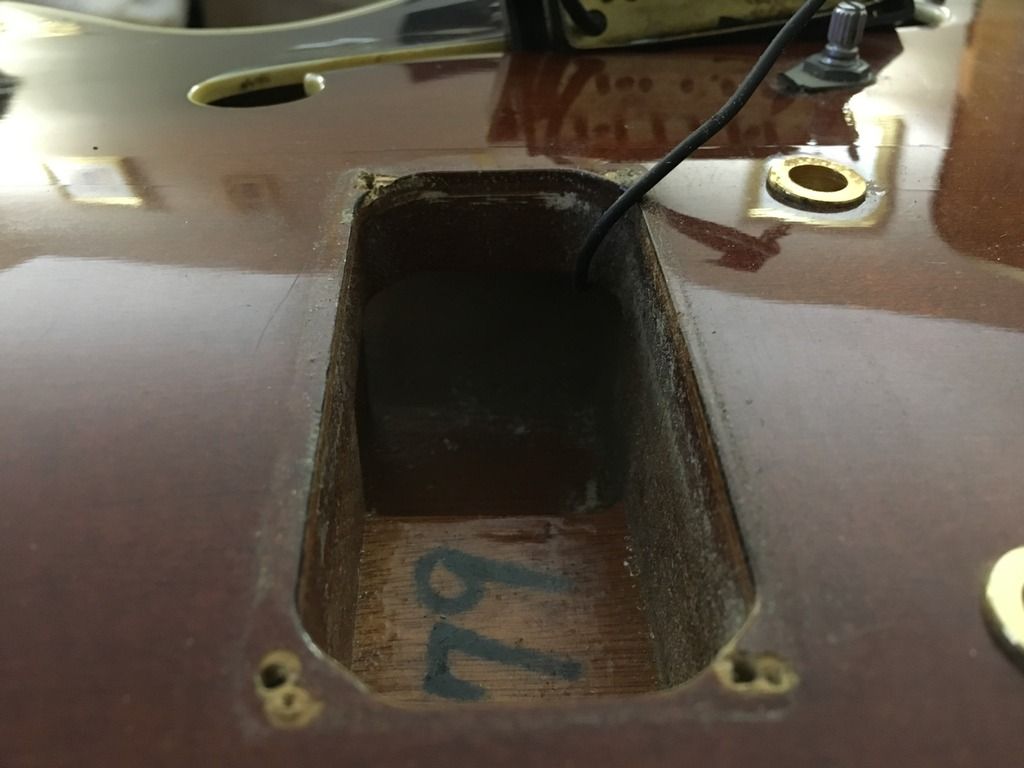
(into the abyss... note the bridge inserts, similar to what they use now (but not interchangeable))
I'm just curious if what's in there is worth keeping, or if I should dive in headfirst and just do it all, seeing how I'm doing the pickups anyway.
I believe I have a set of those Russian PIO's floating around...I recall I bought a couple sets when I rewired my Les Paul. They were pretty reasonably priced.
Thanks for the reply.
B.Last edited by Brian B; 03-24-2017 at 01:49 PM.
-
That is a very nice Emperor T. Those were made for the domestic Japanese market. There is some info on the unofficial Epiphone wiki, however it is not stated what the pots are. I have a Emperor F and I was told that has 500k pots in. Never checked it though. Chances are yours has 500k in it as well. Yours is also Matsumoku made.
And the link to the wiki
Emperor Electric Archtop - The Unofficial Epiphone Wiki
-
Personally, if the pots work and aren't noisy, I'd leave them in. Changing working pots is about the least bang for the buck you can get, and it's a pain to do it. You'll also have to deal with the ground wire to the tailpiece, which is even more of a pain many times. If it were me, and it's certainly not, I'd do the same as was done before, and just splice the new pickups in using the existing wiring. A good solder joint is as good as intact wiring. A poor joint can be trouble, but I know how to solder. Soldering the wires to a pot is much more difficult than soldering wires together, and there is much that can go wrong in the process. If it ain't broke, don't fix it.
-
There's quite a bit of truth there. Thanks.
 Originally Posted by sgosnell
Originally Posted by sgosnell
I think it depends on the specific guitar, but changing out the wiring can do wonders. I can cite as example my 1992 Gibson Les Paul Studio. Here's a before;
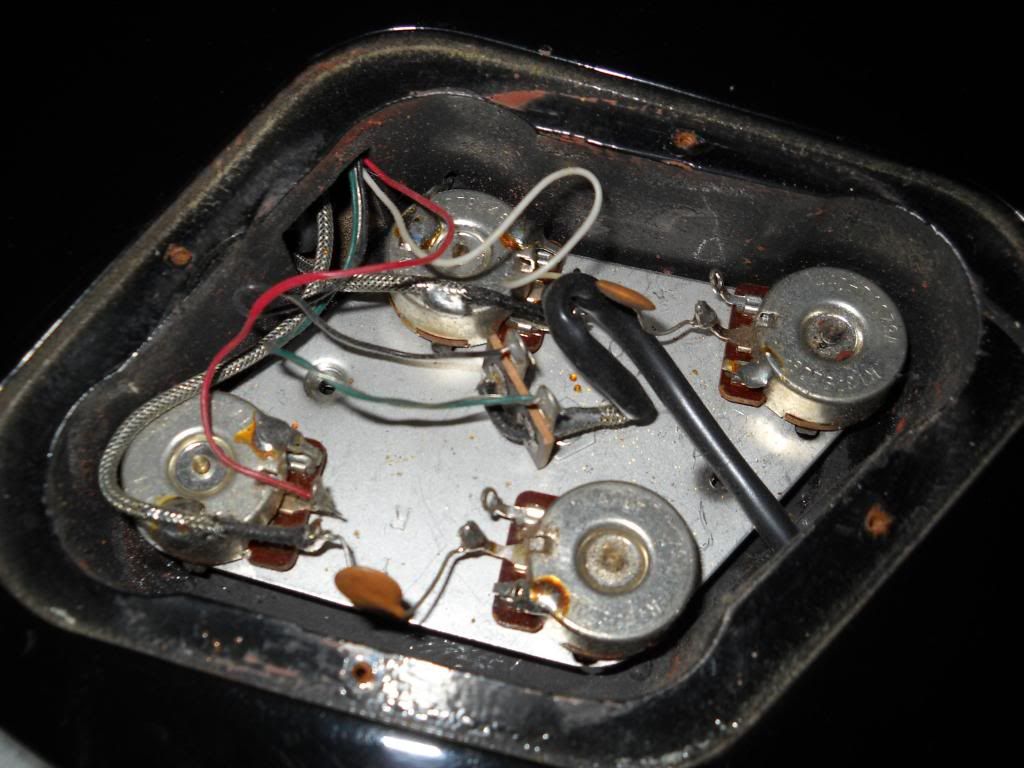
Here's an after;
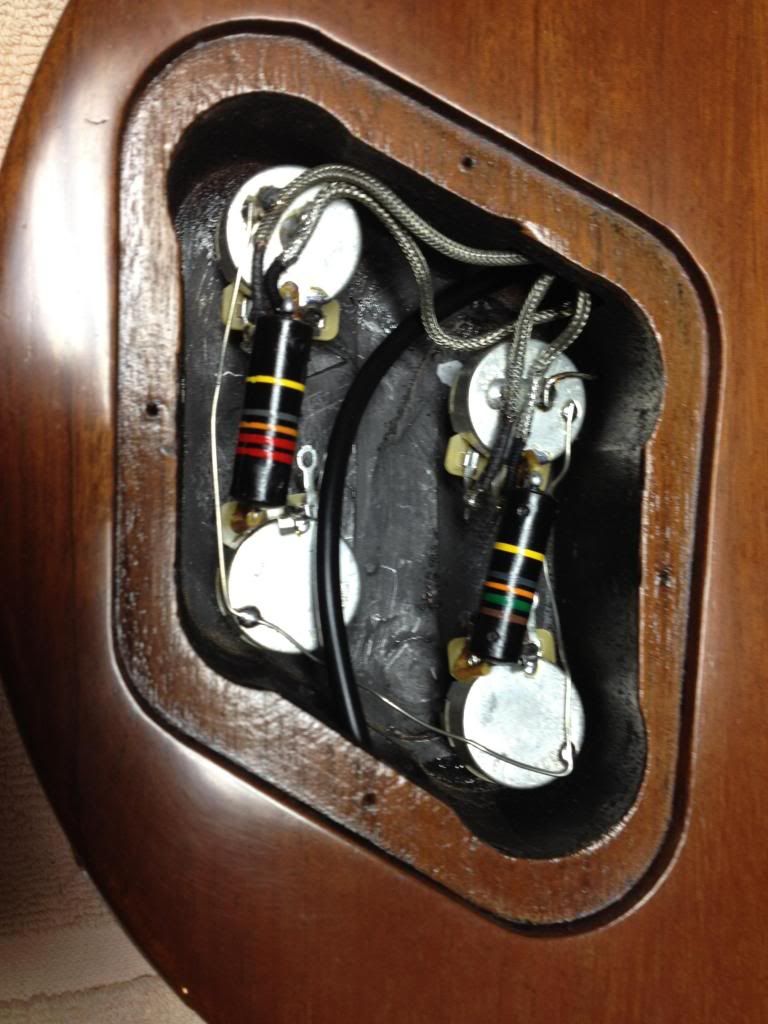
The guitar still has the original 490R and 498T pickups, and sounds much different. The original pots were 300K and had ceramic disc caps. It now has 500Ks and repro PIO bumblebees. But I digress...back to the Epiphone.
" You'll also have to deal with the ground wire to the tailpiece"
Curiously, it's run to the treble side bridge insert. I bought a set of Faber E-serts thinking I'd put them in this, but found these bridge inserts are smaller in diameter than modern Epiphone inserts. And there in the hole was the ground wire, which halted me in my tracks else I'd enlarged the holes right then and there.
So....there's a minor alterior motive to the interest in rewiring... I'd actually prefer running it to the tailpiece than the bridge. I can't help but wonder with the nylon saddles in my bridge as the guitar sits now if the strings and tail are grounded at all....
B.
-
If the saddles are nylon, the strings can't get a ground except through your hands. The bridge ground would work with metal saddles, but I don't see how it could with nylon. It may be tricky getting a wire to the tailpiece, though. I don't know if there is even a way to get one in there if they never ran one. Good luck with that.
500k pots will give a different sound than the 300K that is standard for Gibson. Better or worse is subjective, but if you like the 500k better it's probably worth it. It's your guitar, time, and money.
-
Pretty much what I thought.
 Originally Posted by sgosnell
Originally Posted by sgosnell
The way the neck is pitched on these is very shallow. As it sits, the bridge is adjusted all the way down and cannot go lower. This bridge on it is actually shorter than a standard Gibson ABR or Nashville so swapping one wholesale will raise the action a bit more than I want. I'm currently mulling over the idea of changing the saddles themselves putting metal ones into the bridge. But...
 Originally Posted by sgosnell
Originally Posted by sgosnell
That would be done by taking a thin aircraft drill bit and running a hole from under the Frequensator mount on the rim on an angle through the center block towards the controls. Dremel out a small relief at the edge of the hole so the ground wire will make good contact with the tailpiece but still allow it to sit flush on the body. Done right wouldn't even require the wire be soldered to the tail. The wire would simply need to be long enough to reach out through the bridge pickup rout to solder to the harness as it's being worked on outside the body.
Right. Mats built guitars used higher quality components than their later made Asian counterparts, so one could fairly assume 500K pots were used. But....we know what happens when you assume things... lol Originally Posted by sgosnell
Originally Posted by sgosnell
I'm just thinking if I'm already in there, is there any benefit to doing it? This would allow me to use those E-serts, which would solidify the bridge mounts considerably, ground the tailpiece/strings and let me continue to use the nylon bridge saddles. Thinking big picture, do it once, do it right, and done.
I kind of think I'm talking myself into doing this right now as much as anything...
B.
-
500k pots will give you more highs. If that's what you think it needs, have at it.
-
Hey...I know that name. How are ya Thump?
 Originally Posted by Thumpalumpacus
Originally Posted by Thumpalumpacus

The Epi shares a body construction style with Gibson's ES semi's, but uses a mahogany center block instead of the usual maple. It also has a laminated spruce top instead of maple. So it's naturally a bit darker than an ES. So, yes, I'm leaning towards 500Ks with PIOs wired up ala Gibson '50s.
B.
-
Brian is correct, some interesting tone refinements can be made by wiring on the pots. Increased reliability is another factor to consider: quality new pots can save a performance.
 Originally Posted by Brian B
Originally Posted by Brian B
Changing out the pots is NOT that hard. Pull the knobs, nuts/washers and attach a couple feet of surgical tubing by sliding it over the shafts using your fingers through the F holes to hold the pots in place when you slide on the tubing. After you have done this for the four pots, pull the entire wiring out of the neck pup hole. You will also want to attach tube to the input jack. Leave the sections of tubing in place.
I use a piece of cardboard to hold the pots in place in the same config as the guitar. After wiring is complete and checked on the bench, pull the pots into place through the pup hole. I usually will do the assemble work using the cardboard in advance of pulling the old pots, etc.
Good luck!
-
It may be easy enough to get the ground wire to the tailpiece, but I haven't seen the interior of the guitar so I couldn't say for sure. That's why I said "might". If it's possible to get a straight hole through, and you have the tools, it shouldn't be that big a deal, and I think it would improve the ground. There may be replacement bridges available that are shorter than what is now installed, but i've never searched for them, so good luck in your quest. I have an archtop that needs a lower bridge than standard, but that was easier to solve, because I installed an ebony bridge, and just sanded the bottom of the saddle until I got the necessary fit. Wood is somewhat easier to work than metal.
 As I said earlier, it's your guitar, and you're not me, so you can certainly do whatever you want to it.
As I said earlier, it's your guitar, and you're not me, so you can certainly do whatever you want to it.  Sometimes just getting there, and by your own efforts, is most of the fun. God knows I've spent more time doing my own work on all sorts of things than it will ever be worth, but it was time I mostly enjoyed. I'm doing a little less of it these days, though.
Sometimes just getting there, and by your own efforts, is most of the fun. God knows I've spent more time doing my own work on all sorts of things than it will ever be worth, but it was time I mostly enjoyed. I'm doing a little less of it these days, though.
-
you can get a good estimate of the resistance of the pots by measuring with a multi-meter. The difference between 300k and 500k would be big enough to overcome any imprecision from measuring that way.
 Originally Posted by Brian B
Originally Posted by Brian B
-
i've always thought these were cool. were it a full hollow, i'd have probably tracked one down by now, but they are plenty tempting as is, and there still isn't much out there like them. would love to hear some sounds. also wondering about the neck and weight. you know, just in case.

-
There was a full bodied hollow version, see post 4 above.
 Originally Posted by feet
Originally Posted by feet
Unless you mean a thinline hollow ala Epiphone Casino....
The neck is really comfortable playing. Might even be thinner than my SG. As far as weight, I can answer that one too... Where I work recently added a Family Health department to their medical services, which included a scale for weighing infants. So I brought my "baby" to work one day to be weighed...lol
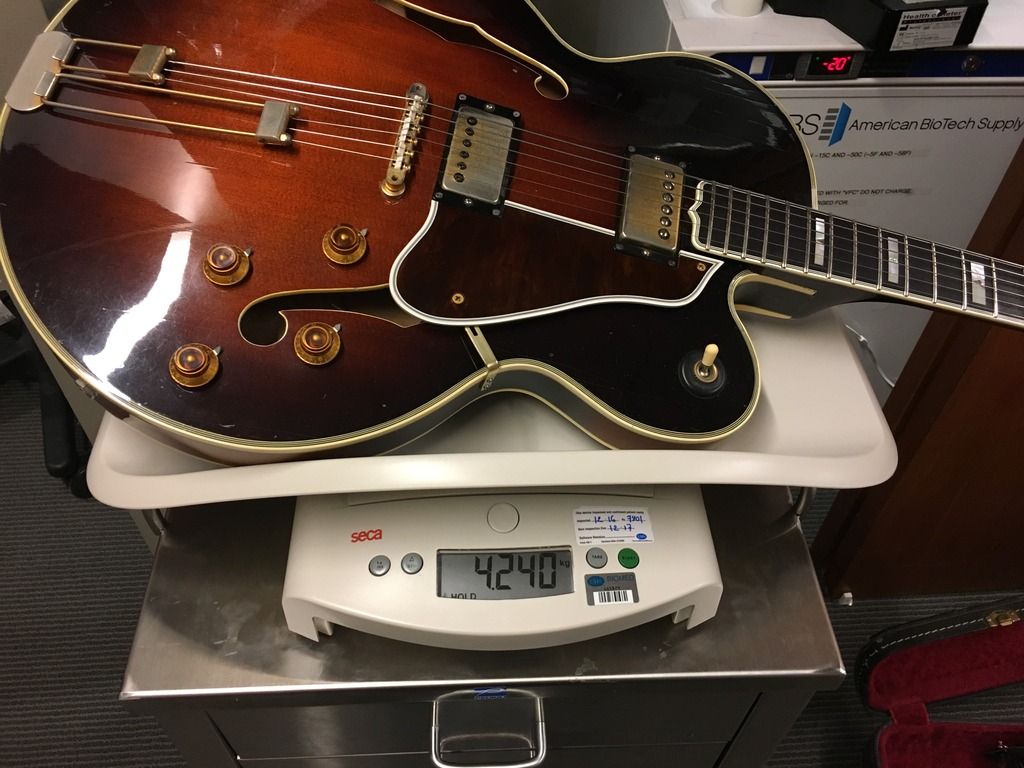
4.240kg = 9.3476 pounds.
B.
-
hmm... that's a little heavier than i'd like, though i bet it distributes the weight well, given the size. that's about what my number one weighs. but yeah, the dream was a big skinny hollowbody, which doesn't really exist, for whatever reason. i have a couple and its awesome.
still, i bet these are different enough from an es335 type guitar that its still worth considering. a gretsch center block falcon is smaller and about a pound lighter, but its also more than twice the price. hofner makes a slim, single cut hollow, but i'd prefer a german model, if i was to go that route. i have a bunch of japanese epiphones already, so this feels safer.
-
Every top end Matsumoku I have played has been a winner. I still play my "Super-V" more than I play my high end, carved archtops.
It plays like a dream and the electric sound through a Polytone is very compelling.
I have always wanted one of the Epiphone Emperor F instruments. I hadn't seen the "T" until now. It clearly looks to be a Matsumoku guitar. I can see where it would fit right in there in anyone's collection. NICE guitar.
-
I have one and like it a lot. It has a nice dark thunk to its tone. I’d say it’s more suited for electrical playing.
The quality of the Matsumoku made guitars is perfect. The Emperor has a very luxurious feel to it. And i love the looks with its dark antique burst and the frequensator tailpiece, although I can’t tell if it makes a difference sound wise
-
Since it's a Matsumoku laminate built to L5ces specs, I suspect it isn't much different from the Aria Pro II PE180 and its siblings. Fantastic guitars! All the sweetness of the L5ces with a nice undercurrent of ES350 thunk.
 Originally Posted by Duotone
Originally Posted by Duotone
-
This video (which you probably already know) gives a quite good representation of its sound:
Visually, mine looks quite bit darker than the one in the video.
-



-
These are great value for the money. I once had two of them in the garden, which was a rare occasion. The one on the right hand side was mine. I sold it and upgraded to a L5CT
-




 Reply With Quote
Reply With Quote







Grant Green, What is This Thing
Yesterday, 01:59 PM in Ear Training, Transcribing & Reading